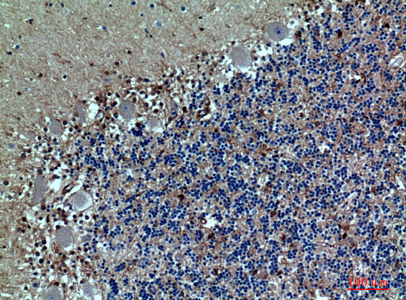PSGL-1 Polyclonal Antibody
- Catalog No.:YT5572
- Applications:WB;IHC;IF;ELISA
- Reactivity:Human;Mouse
- Target:
- PSGL-1
- Fields:
- >>Cell adhesion molecules;>>Neutrophil extracellular trap formation;>>Staphylococcus aureus infection
- Gene Name:
- SELPLG
- Protein Name:
- P-selectin glycoprotein ligand 1
- Human Gene Id:
- 6404
- Human Swiss Prot No:
- Q14242
- Mouse Swiss Prot No:
- Q62170
- Immunogen:
- The antiserum was produced against synthesized peptide derived from the N-terminal region of human SELPLG. AA range:1-50
- Specificity:
- PSGL-1 Polyclonal Antibody detects endogenous levels of PSGL-1 protein.
- Formulation:
- Liquid in PBS containing 50% glycerol, 0.5% BSA and 0.02% sodium azide.
- Source:
- Polyclonal, Rabbit,IgG
- Dilution:
- WB 1:500 - 1:2000. IHC: 1:100-1:300. ELISA: 1:10000.. IF 1:50-200
- Purification:
- The antibody was affinity-purified from rabbit antiserum by affinity-chromatography using epitope-specific immunogen.
- Concentration:
- 1 mg/ml
- Storage Stability:
- -15°C to -25°C/1 year(Do not lower than -25°C)
- Other Name:
- SELPLG;P-selectin glycoprotein ligand 1;PSGL-1;Selectin P ligand;CD162
- Observed Band(KD):
- 45 110kd(glycosylated)
- Background:
- This gene encodes a glycoprotein that functions as a high affinity counter-receptor for the cell adhesion molecules P-, E- and L- selectin expressed on myeloid cells and stimulated T lymphocytes. As such, this protein plays a critical role in leukocyte trafficking during inflammation by tethering of leukocytes to activated platelets or endothelia expressing selectins. This protein requires two post-translational modifications, tyrosine sulfation and the addition of the sialyl Lewis x tetrasaccharide (sLex) to its O-linked glycans, for its high-affinity binding activity. Aberrant expression of this gene and polymorphisms in this gene are associated with defects in the innate and adaptive immune response. Alternate splicing results in multiple transcript variants.[provided by RefSeq, Apr 2011],
- Function:
- function:A SLe(x)-type glycan, which through high affinity, calcium-dependent interactions with E-, P- and L-selectins, mediates rapid rolling of leukocytes over vascular surfaces during the initial steps in inflammation. PSGL1 is critical for the initial leukocyte capture.,online information:P-selectin glycoprotein ligand 1 entry,PTM:Displays complex, core-2, sialylated and fucosylated O-linked oligosaccharides, at least some of which appear to contain poly-N-acetyllactosamine with varying degrees of substitution. Mainly disialylated or neutral forms of the core-2 tetrasaccharide, Galbeta1-->4GlcNAcbeta1-->6(Galbeta1-->3)GalNAcOH. The GlcN:GalN ratio is approximately 2:1 and the Man:Fuc ratio 3:5. Contains about 14% fucose with alpha-1,3 linkage present in two forms: One species is a disialylated, monofucosylated glycan, and the other, a monosialylated, trifucosylated glycan with a poly
- Subcellular Location:
- Membrane; Single-pass type I membrane protein.
- Expression:
- Expressed on neutrophils, monocytes and most lymphocytes.
- June 19-2018
- WESTERN IMMUNOBLOTTING PROTOCOL
- June 19-2018
- IMMUNOHISTOCHEMISTRY-PARAFFIN PROTOCOL
- June 19-2018
- IMMUNOFLUORESCENCE PROTOCOL
- September 08-2020
- FLOW-CYTOMEYRT-PROTOCOL
- May 20-2022
- Cell-Based ELISA│解您多样本WB检测之困扰
- July 13-2018
- CELL-BASED-ELISA-PROTOCOL-FOR-ACETYL-PROTEIN
- July 13-2018
- CELL-BASED-ELISA-PROTOCOL-FOR-PHOSPHO-PROTEIN
- July 13-2018
- Antibody-FAQs
- Products Images

- Western Blot analysis of NIH-3T3 cells using PSGL-1 Polyclonal Antibody. Secondary antibody(catalog#:RS0002) was diluted at 1:20000

- Immunohistochemical analysis of paraffin-embedded human-brain, antibody was diluted at 1:100



